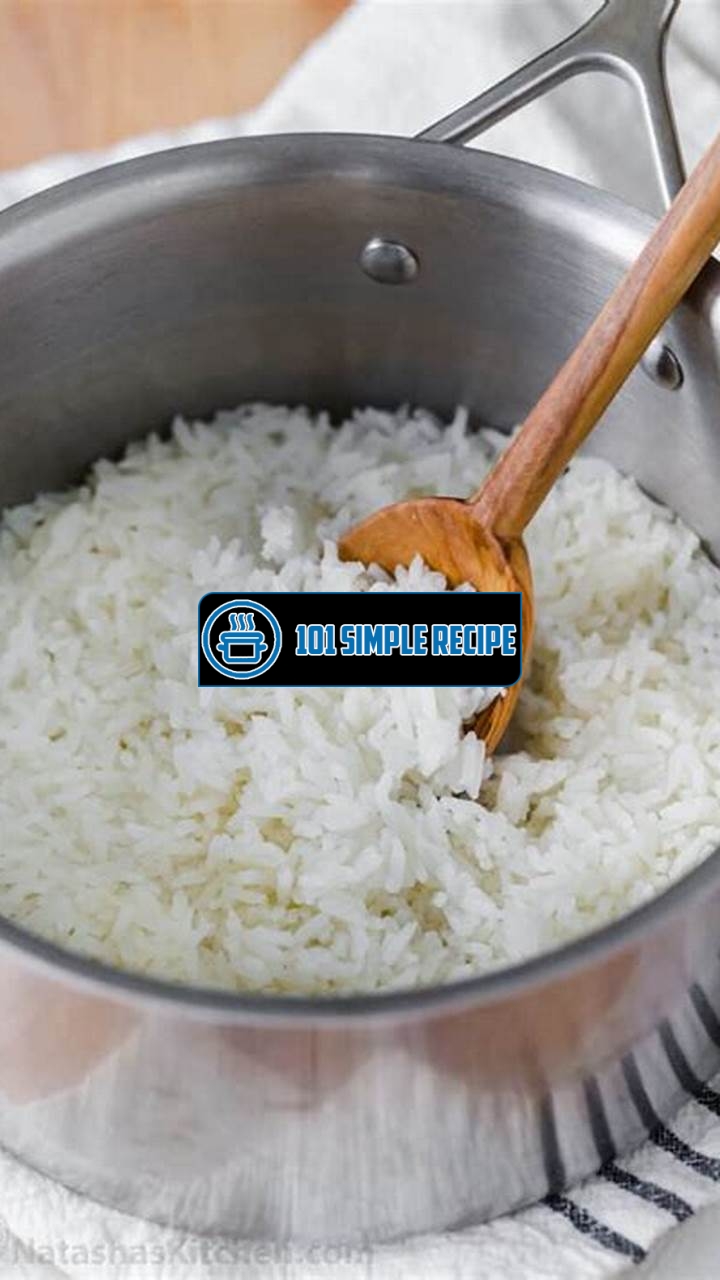Welcome to your foolproof guide to cooking rice perfectly! Whether you’re a seasoned chef or a beginner in the kitchen, cooking rice can sometimes be a tricky task. But fear not! With the help of this comprehensive guide, you will soon be able to achieve fluffy, delicious rice every single time. From choosing the right type of rice to mastering the cooking techniques, we’ve got you covered. So, grab your apron and let’s dive right in!

Understanding Different Types of Rice
When it comes to cooking rice, not all varieties are created equal. Each type of rice has its own unique characteristics that affect its texture, flavor, and cooking method. In this guide, we will explore the different types of rice and provide you with a better understanding of how to cook them perfectly.
Long-Grain Rice
In the world of rice, long-grain rice is perhaps the most versatile and widely consumed. With its slender grains that stay separate and fluffy when cooked, it is the perfect choice for dishes like pilafs, curries, and stir-fries. This type of rice has a subtle nutty flavor that pairs well with both savory and sweet dishes.
Long-grain rice also comes in different varieties such as Basmati and Jasmine. Basmati rice, known for its aromatic fragrance and delicate flavor, is commonly used in Indian and Middle Eastern cuisines. Jasmine rice, on the other hand, has a floral aroma and is a staple in Southeast Asian cooking.
When cooking long-grain rice, the general rule is to use a ratio of 1:2 – one part rice to two parts water. Rinse the rice under cold water before cooking to remove any excess starch. Bring the water to a boil, add the rice, and then reduce the heat to low. Cover the pot and let it simmer for about 15-20 minutes until the water is absorbed and the rice is tender. Fluff the rice with a fork before serving.
Short-Grain Rice
Short-grain rice has a plump and starchy texture, making it stickier and clump together when cooked. It is commonly used in dishes that require a sticky consistency, such as sushi, risotto, and rice pudding. Due to its high starch content, short-grain rice also tends to absorb flavors more effectively.
One of the most popular varieties of short-grain rice is Arborio rice, which is essential for making creamy and rich risotto. Another well-known variety is sushi rice, which is the key ingredient in making sushi rolls.
When cooking short-grain rice, the ratio of rice to water is usually 1:1.25 – one part rice to one and a quarter parts water. Rinse the rice to remove excess starch, then combine it with water in a pot. Bring it to a boil, then reduce the heat to low and cover the pot. Allow it to simmer for about 15 minutes until the water is absorbed and the rice becomes tender and sticky. Use a wooden spatula to gently fluff the rice before serving.
Medium-Grain Rice
Medium-grain rice strikes a balance between long-grain and short-grain rice. It has a slightly sticky texture when cooked, making it a great option for dishes like paella, risotto, and rice pudding. This type of rice is commonly used in Mediterranean and Italian cuisines.
An example of medium-grain rice is Calrose rice, which is widely used in Asian cuisine and is perfect for making sushi rice. It is known for its ability to absorb flavors and retain moisture, resulting in a delicious and fluffy final product.
The cooking method for medium-grain rice is similar to that of short-grain rice. The ratio of rice to water is usually 1:1.25, and it should be rinsed before cooking. Bring the rice and water to a boil, then reduce the heat to low and cover the pot. Let it simmer for about 15 minutes until the water is absorbed, and the rice is tender. Gently fluff the rice with a fork before serving.
In conclusion, understanding the different types of rice is crucial for achieving the perfect cooking results. Whether you are making a flavorful Indian curry with Basmati rice or a creamy Italian risotto with Arborio rice, knowing the characteristics of each type will help you cook rice like a pro. So next time you’re in the kitchen, remember these tips and enjoy your perfectly cooked rice every time!
Choosing the Right Rice
When it comes to cooking rice, selecting the right type is essential for achieving perfect results. With so many varieties available, it can be overwhelming to choose the one that best suits your dish. But fret not! In this guide, we’ll walk you through the process of selecting the perfect rice for your culinary creations.
Finding the Right Texture
Texture is a crucial factor to consider when choosing rice. It determines whether the rice will turn out fluffy, sticky, or somewhere in between. Different dishes call for different textures, so let’s take a closer look at your options.
- Long-Grain Rice: This variety, such as Jasmine or Basmati, produces separate and fluffy grains when cooked. It is perfect for dishes like pilaf or stir-fries.
- Medium-Grain Rice: With a slightly stickier texture compared to long-grain rice, medium-grain varieties like Arborio and Calrose are ideal for risottos, paellas, and sushi.
- Short-Grain Rice: Short-grain rice, like sushi rice or sticky rice, has a high starch content, making it perfect for dishes that require a sticky consistency, such as sushi or rice pudding.
Note: The rule of thumb is that starchier rice produces stickier rice, while rice with less starch results in fluffier grains.
Considering the Flavor Profile
Each rice variety possesses its own unique flavor profile. Some have a subtle taste that complements a wide range of dishes, while others have a more pronounced flavor that can enhance specific culinary creations. Here are a few examples:
- Basmati Rice: Known for its aromatic and nutty flavor, Basmati rice pairs well with Indian and Middle Eastern dishes.
- Arborio Rice: With its creamy and slightly chewy texture, Arborio rice is perfect for creamy risottos and rice puddings.
- Black Rice: Offering a unique nutty taste and a striking dark color, black rice adds an exotic touch to salads and desserts.
Note: Consider the flavor profile of the rice and how it complements or adds depth to your dish.
Understanding Cooking Methods for Different Rice Varieties
Each rice variety requires a specific cooking method to achieve optimal results. Here are some common cooking methods based on rice varieties:
| Rice Variety | Cooking Method |
|---|---|
| Long-Grain Rice | Typically cooked using the absorption method, where the rice is simmered with water until all the liquid is absorbed. |
| Medium-Grain Rice | Often cooked using the absorption method, but may require shorter cooking times and slightly less water compared to long-grain rice. |
| Short-Grain Rice | Usually cooked by adding a specific amount of water and simmering until the rice is tender and sticky. |
Note: Be sure to follow the recommended cooking instructions for the specific rice variety you have chosen.
By understanding how to choose the right rice based on texture, flavor profile, and cooking methods, you’ll be well on your way to cooking rice perfectly every time! Experiment with different varieties and enjoy the delicious results they bring to your dishes.
Preparing Rice for Cooking
Master the crucial steps to properly prepare rice for cooking. In order to achieve perfectly cooked rice, it is essential to pay attention to the preparation process. This includes rinsing the rice, soaking it, and then draining it before cooking.
Rinsing the Rice
Start by rinsing the rice thoroughly under cold water. Rinsing the rice helps to remove any excess starch and impurities. Place the rice in a fine mesh strainer and run cold water over it, gently swishing the rice around with your fingers. Continue rinsing until the water runs clear.
Important note: Rinsing the rice is crucial as it helps to remove the surface starch, which can make the rice sticky if not rinsed properly. Rinsing also removes any remaining dirt or debris that may be present.
Soaking the Rice
After rinsing, the next step is to soak the rice. Soaking allows the rice to absorb water, which helps in achieving a fluffy and evenly cooked texture. Place the rinsed rice in a bowl and add enough water to cover it completely. Let the rice soak for at least 30 minutes to an hour.
Important note: Soaking the rice is especially important for certain types of rice, such as basmati or jasmine rice. Soaking helps to soften the grains, resulting in a more tender and flavorful rice.
Draining the Rice
Once the rice has finished soaking, it’s time to drain off the excess water. Carefully pour the soaked rice into a fine mesh strainer or colander, allowing the water to completely drain out. Shake the strainer gently to remove any excess water.
Important note: Draining the rice is important to remove any excess water, as using too much water can lead to mushy rice. Proper draining ensures that the rice absorbs just the right amount of water during cooking, resulting in perfectly cooked grains.
By following these crucial steps of preparing rice for cooking, you can ensure that your rice turns out perfectly cooked every time. Remember to rinse the rice thoroughly, soak it for the appropriate amount of time, and drain off any excess water. Armed with this knowledge, you are now ready to embark on your rice-cooking journey with confidence!
Cooking Methods and Ratios
When it comes to cooking rice, there are several methods you can try. Each method requires a different rice-to-water ratio to ensure perfectly cooked rice. In this guide, we will explore three popular cooking methods: stovetop cooking, rice cooker method, and Instant Pot method.
Stovetop Cooking
Stovetop cooking is the traditional method of cooking rice and requires a bit of attention to achieve the best results. To get started, you’ll need a saucepan with a tight-fitting lid. Follow these steps:
- Rinse the rice: Rinse the rice under cold water until the water runs clear. This helps remove any excess starch.
- Measure the rice and water: For every cup of rice, you’ll need 2 cups of water. This ratio ensures fluffy and perfectly cooked rice.
- Boil the water: Place the saucepan over medium heat and bring the water to a boil.
- Add rice and salt: Once the water is boiling, add the rinsed rice and a pinch of salt. Stir gently to prevent sticking.
- Cover and simmer: Reduce the heat to low, cover the saucepan with the lid, and let the rice simmer for about 18-20 minutes. Avoid removing the lid during this process to maintain steam.
- Fluff and serve: After the cooking time, remove the saucepan from the heat and let it sit, covered, for another 5 minutes. Then, fluff the rice with a fork and serve hot.
Note: Stovetop cooking produces deliciously fluffy rice, but it requires attention to prevent burning or sticking. Keep an eye on the heat and cooking time for the best results.
Rice Cooker Method
A rice cooker is a convenient kitchen appliance that takes the guesswork out of cooking rice. Here’s how to cook rice using a rice cooker:
- Rinse the rice: Rinse the rice under cold water until the water runs clear to remove excess starch.
- Measure the rice and water: For every cup of rice, you’ll need 1.5 cups of water. This ratio may vary depending on the rice cooker model, so consult the manufacturer’s instructions.
- Add rice and water to the cooker: Place the rinsed rice and water in the rice cooker.
- Select the cooking mode: Close the lid and select the appropriate cooking mode on your rice cooker (usually labeled as “white rice” or “regular rice”).
- Start the cooking cycle: Press the start button and let the rice cooker do its magic. It will automatically adjust the cooking time and temperature.
- Fluff and serve: Once the cooking cycle is complete, let the rice sit for a few minutes, then fluff it with a fork before serving.
Note: Rice cookers provide consistent results and are incredibly easy to use. Follow the manufacturer’s instructions for the best cooking experience.
Instant Pot Method
The Instant Pot is all the rage in the kitchen these days, and it can also be used to cook rice. Here’s how:
- Rinse the rice: Rinse the rice under cold water to remove any excess starch.
- Measure the rice and water: For every cup of rice, you’ll need 1.25 cups of water. This ratio is slightly different from stovetop cooking.
- Add rice and water to the Instant Pot: Place the rinsed rice and water in the Instant Pot.
- Close the lid and set the pressure: Seal the Instant Pot lid and set the pressure release valve to the “Sealing” position.
- Select the cooking mode: Press the “Rice” button on the Instant Pot and let it do its job.
- Natural or quick release: After the cooking cycle, you can choose to do a natural pressure release or a quick pressure release, depending on your preference.
- Fluff and serve: Once the pressure is released, open the Instant Pot, fluff the rice with a fork, and serve.
Note: The Instant Pot method offers convenience and saves time. Familiarize yourself with the Instant Pot settings and follow safety instructions for a smooth cooking process.
Troubleshooting Rice Cooking Issues
In your quest to cook rice perfectly, you may encounter some common problems that can leave you with less-than-desirable results. But fear not! With the right knowledge and techniques, you can overcome these issues and achieve a perfect batch of rice every time.
Sticky or Clumpy Rice
One of the most common problems when cooking rice is ending up with a sticky or clumpy texture. This can happen if you use the wrong type of rice or if you don’t rinse it properly before cooking. To avoid this, always choose a long-grain rice variety, such as Basmati or Jasmine, which have a lower starch content. Additionally, make sure to rinse the rice thoroughly under cold water before cooking to remove any excess starch.
Important Note: Avoid stirring the rice excessively while it’s cooking as this can release more starch and make it stickier. Instead, simply fluff the rice with a fork after it’s done cooking.
Dry and Undercooked Rice
Another issue you may face is ending up with dry and undercooked rice. This can occur if you don’t use enough water or if you remove the lid too often during the cooking process, resulting in a loss of steam. To ensure your rice is perfectly cooked, always follow the recommended water-to-rice ratio mentioned on the packaging or in your recipe. Generally, the ratio is 1:2 (one cup of rice to two cups of water), but it can vary depending on the type of rice.
Important Note: ⏰ Don’t lift the lid before the cooking time is up. Trust the process and allow the rice to steam undisturbed. Only remove the lid once the cooking time is complete.
Burnt or Overcooked Rice
Lastly, burnt or overcooked rice can be a disappointing outcome. This usually happens when the heat is too high or the cooking time is too long. To prevent this, use a heavy-bottomed pot or a rice cooker that distributes heat evenly. Additionally, reduce the heat to low once the water comes to a boil and cover the pot tightly with a lid.
Important Note: If you notice the rice sticking to the bottom of the pot, resist the temptation to scrape it off. Instead, transfer the rice to a new serving dish, leaving the burnt layer behind.
By troubleshooting these common rice cooking issues and following the tips provided, you can ensure that your next batch of rice turns out perfectly fluffy and delicious. Remember to choose the right type of rice, rinse it thoroughly, use the correct water-to-rice ratio, and control the heat and cooking time. Happy cooking!
Frequently Asked Questions
If you still have questions about how to cook rice, we’ve compiled some commonly asked ones below:
| No. | Questions | Answers |
|---|---|---|
| 1. | How much water should I use to cook rice? | The general rule is to use a 1:2 ratio of rice to water. For example, if you’re cooking 1 cup of rice, you should use 2 cups of water. |
| 2. | Should I rinse the rice before cooking? | Yes, it’s recommended to rinse the rice before cooking to remove any excess starch and improve the texture of the cooked rice. |
| 3. | What heat setting should I use to cook rice? | Start cooking rice on high heat until it comes to a boil, then reduce the heat to low and cover the pot. Let it simmer for about 15-20 minutes until the rice is cooked. |
| 4. | How do I know when the rice is done cooking? | You can check if the rice is done by tasting a grain. The cooked rice should be tender with a little bite, not mushy or crunchy. |
| 5. | Can I cook rice without a rice cooker? | Yes, you can cook rice on the stovetop using a pot with a tight-fitting lid. Just follow the instructions for water and heat settings mentioned earlier. |
| 6. | What can I do if my rice turns out sticky? | If your rice turns out sticky, try rinsing it more thoroughly before cooking and using slightly less water. You can also fluff the cooked rice with a fork to separate the grains. |
Thanks for Reading!
We hope you found our guide on how to cook rice helpful and that you’re now confident in preparing a perfect batch every time. Remember to visit again in the future for more culinary tips and recipes. Happy cooking!
Jump to Recipe
How to Cook Rice

Learn how to cook rice and achieve perfectly fluffy, delicious grains every time. Our step-by-step guide provides all the tips you need for rice cooking success.
- 1 cup of rice
- 2 cups of water
- 1/2 teaspoon of salt (optional)
- Place the rice in a fine-mesh strainer and rinse it thoroughly under cold water. Swirl the rice around with your hand to remove any excess starch. Repeat until the water runs clear.
- In a medium saucepan, combine the rinsed rice, 2 cups of water, and salt, if desired. Bring to a boil over high heat.
- Once the water is boiling, reduce the heat to low and cover the pot with a tight-fitting lid. Let the rice simmer for 15-20 minutes, or until all the water is absorbed.
- Remove the pot from the heat and let it sit, covered, for 5 minutes. Then, use a fork to fluff the rice and separate the grains. Serve immediately and enjoy!






